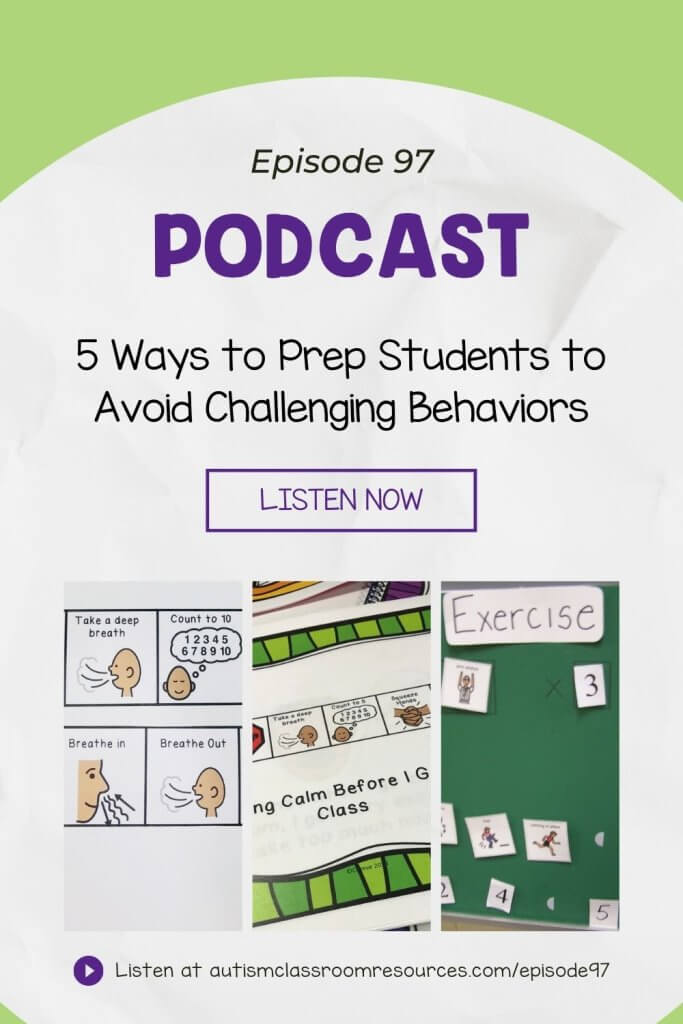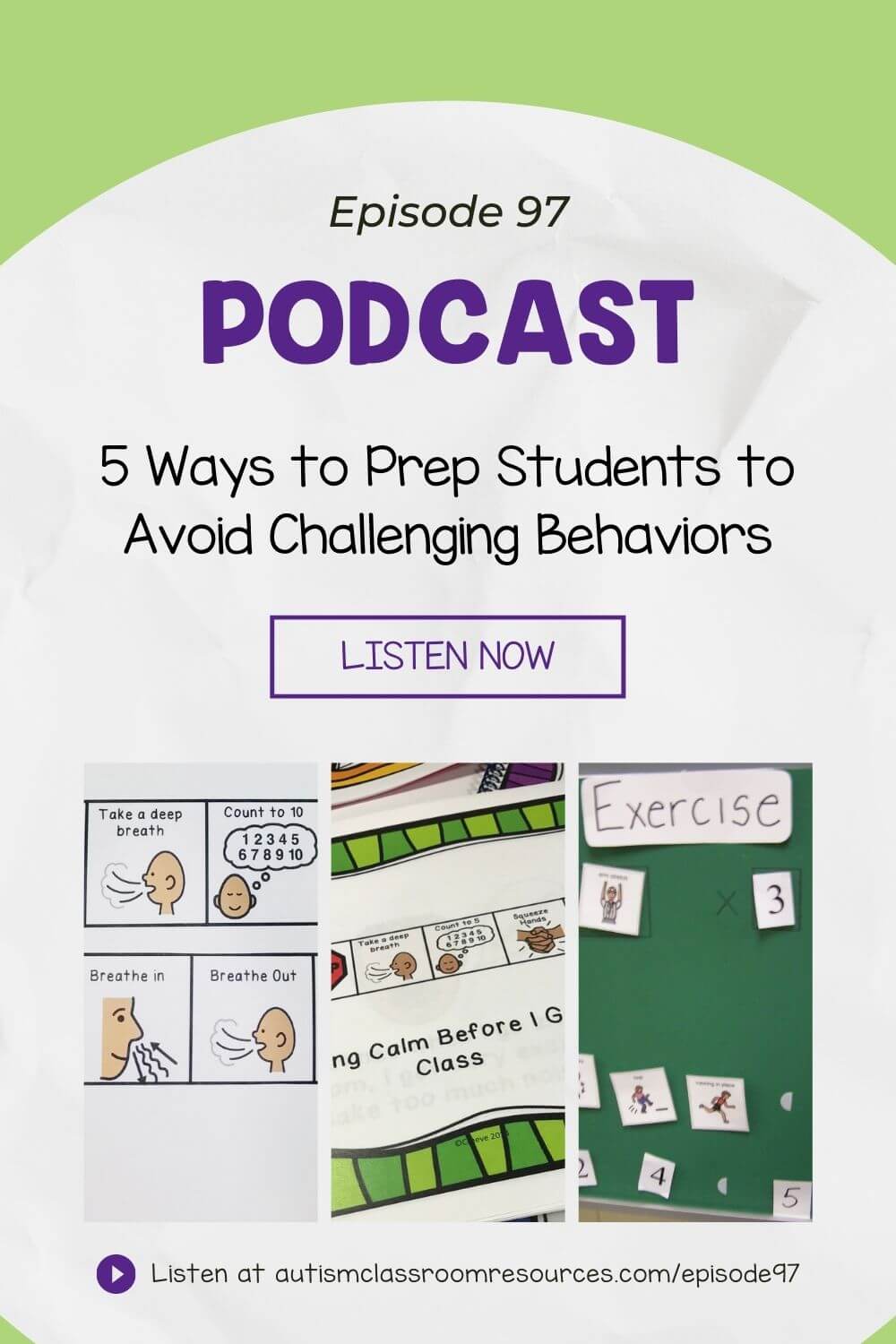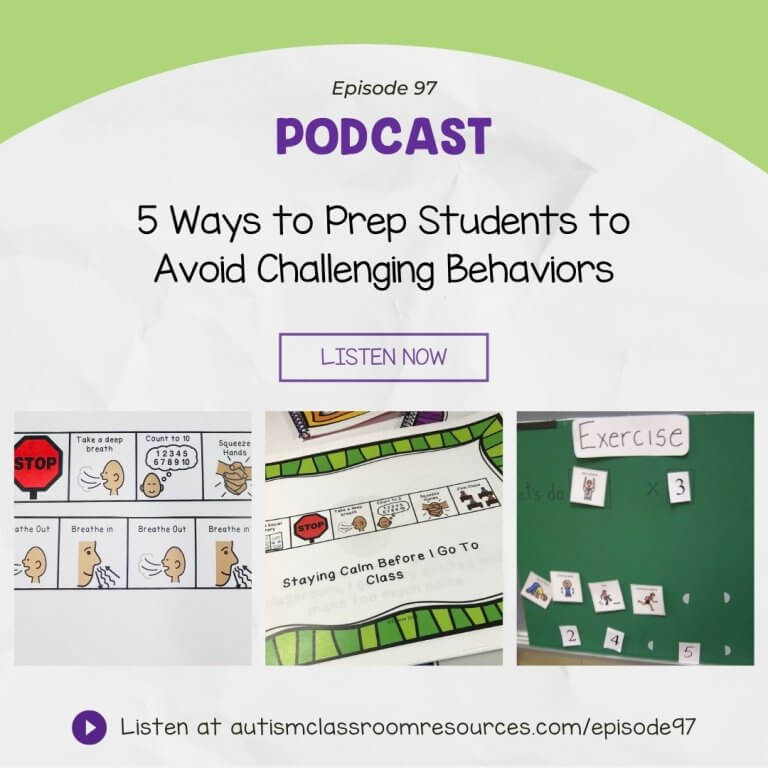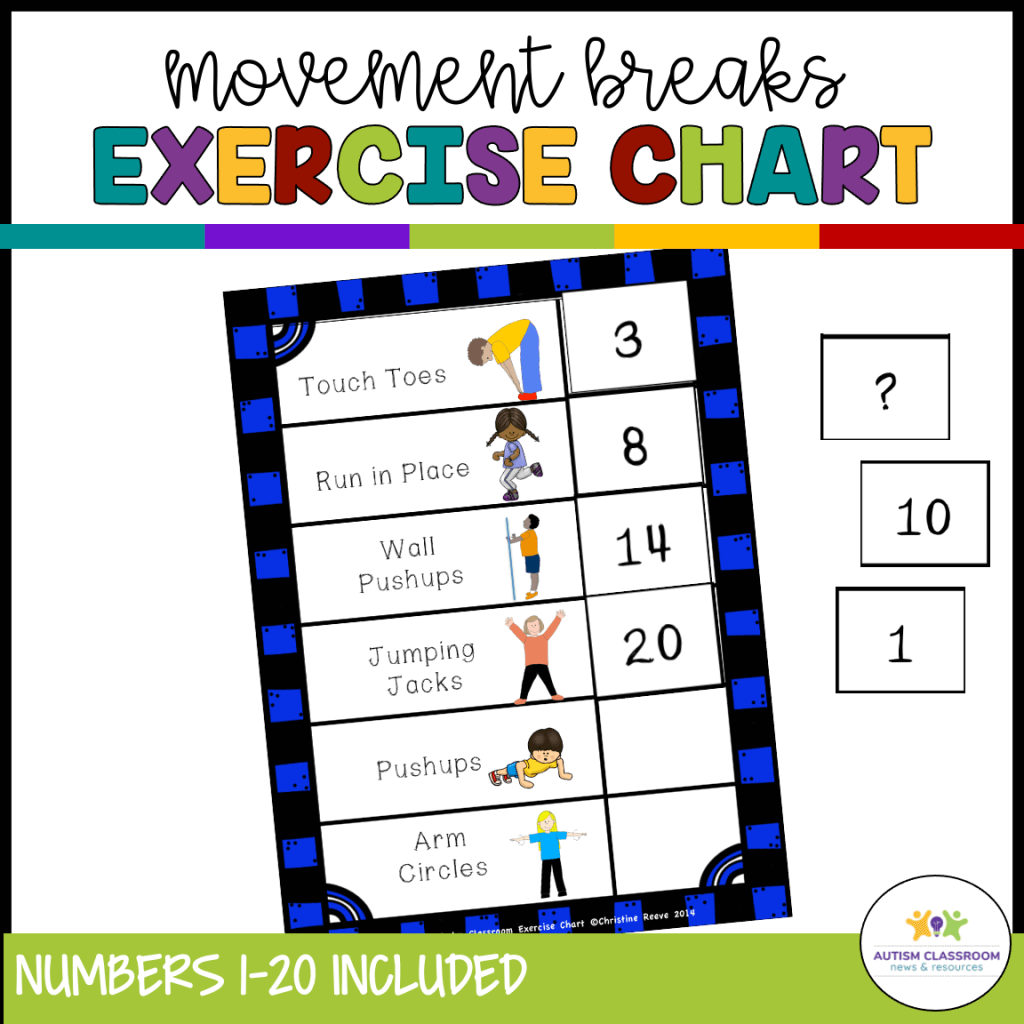Welcome to the Autism Classroom Resources Podcast, the podcast for special educators who are looking for personal and professional development.
Christine Reeve: I’m your host, Dr. Christine Reeve. For more than 20 years, I’ve worn lots of hats in special education but my real love is helping special educators like you. This podcast will give you tips and ways to implement research-based practices in a practical way in your classroom to make your job easier and more effective.
Welcome back to the Autism Classroom Resources Podcast. I’m Chris Reeve and I’m your host. We are in the midst of talking about ways to address challenging behavior in the classroom because it’s that time of year and frankly, it’s that kind of year. I’m recording this in the fall of 2021, so it’s that kind of year. Today, I want to talk about ways that we can actually prepare students to avoid challenging behaviors from happening because wouldn’t you rather just avoid problem behavior? I’m guessing that no one really likes to be hit or spit at. Obviously, these aren’t going to solve all the problems but they can cut back on the things that require the bigger assessment and approach, and narrow down the things that you have to worry about. I’ve got some free tools that will help you with these five things as well. I’ll share those with you as we go through. Let’s get started.
As I said, we’re going to focus on strategies that will prepare a student and essentially prevent problem behaviors. Now, obviously, we’re not really necessarily preventing them, we’re really using antecedent strategies to avoid them. For sometimes, it may be an antecedent strategy because we’re teaching them strategies that they can use on their own to prevent strategies the same way that we do. I have certain strategies that I use before I go into situations that help me not have problem behaviors in those situations. I may have a relaxation routine before I walk into a big meeting with my boss or something like that because sometimes, preparing someone before they have to manage a difficult situation can help them manage their behavior and sometimes, when we’ve done that enough times, they’ve learned to do it on their own. Think of it as when you remind your significant other that we decided to try not to argue with the in-laws during dinner tonight. Over time, we can’t hope that they will do that on their own without our reminders. We all do it. It’s just a matter of making the preparation more clear and meaningful for our students, and making sure that we’ve planned the time to be able to do it before we go to that situation.
This is something that we’re teaching them often some self-regulation, often some strategies but we’re doing it up front so that we’re avoiding a situation but we’re also teaching them strategies that may prevent the situation or prevent the problems later on. The first one that I want to talk about is transition warnings. This is more of an antecedent strategy. It’s a prevention strategy or an antecedent strategy we might put in a behavior plan. It’s probably one of the most common strategies that we use. It’s to warn a student prior to asking him to make a transition from a desired activity to a less desired activity. For instance, we might give him a two minute warning, then a one minute warning before we ask him to put an iPad away and go to a work activity.
We might do it with a timer by setting down a visual as a reminder or we might just call out two minutes left, then it’s time for. This is a warning that lets them get ready for the upcoming transition. Sometimes, it makes the transition more independent. Other times, it can just prevent the tantrum because it’s not a surprise. This works really well if your FBA showed that the challenging behaviors were related to transitions of leaving desired activities. When you know that those things are an issue, those highlight times that we can put this preventive strategy in place and it’s something that we can often help them do. Now sometimes, we often compare this to a replacement strategy of being able to say, “I want another minute.” Maybe we build that in as a strategy, as a tool for that student too.
The second strategy is to pre-teach the student strategies or material that they’re going to need to be successful in the next activity. We often talk about pre-teaching for students who are included in general education activities but it’s for students who benefit from knowledge about the academic content prior to going into a larger environment. For students with challenging behaviors that are related to escaping from that bigger environment or from those tasks, in general, we could use this in any environment with any students, we can pre-teach the content of those difficult academic times, which then may prevent challenging behaviors because we’ve made the demands more familiar and we’ve made them easier because they’ve had some individual instruction, and practice in a smaller environment.
For instance, if we have a student who has difficulty going into science with this class, pre-teaching the experiment he’s going to do in a smaller environment, like the resource classroom and having him practice it, and knowing what’s going to happen may make that science class less difficult for him, so we’re bringing the difficulty down, which may prevent challenging behavior. The key to this strategy obviously is to program this time into his day and collaborate across the two classes about what that content is going to be so that you know about it ahead of time, and can pre-teach it. If you don’t have it scheduled into the day, then that pre-teaching isn’t going to happen. Think about when you’re going to pre-teach as you make the students schedules throughout the year. Now, over time, you may have to pre-teach less but pre-teaching that material may lower the demands, which may make the task easier and reduce that frustration or that difficulty that sets off those problem behaviors.
The third thing that you could do is do a pre-activity preparation. Now, this is very similar to what you see many teachers do when they’re going on a field trip. For some of our students, it might be preparing them behaviorally before they go into a difficult situation. It might be having the student go through a relaxation routine before he goes into a difficult situation so that they’re calm and ready before they walk in. It could be reviewing the expectations of an activity before they go into a new situation. Again, this is something general ed teachers do before we go on a field trip. I remember seeing a kindergarten teacher before the kindergarteners were going to their first play. She was talking about, “Now, we’re going to go into the theater. It’s going to be big and it’s going to be loud but we’re going to use our quiet voices. We’re going to walk down the aisle, then we’re going to go find our seat, and we’re not going to pull on the seats of every seat we pass.” She was explaining to them what the expectations were. That’s one example of this.
But you could also do it as we’re going to go in, before we walk into class, we’re going to stop and we’re going to take a deep breath. I might use visuals to show the students a strip of visuals. We’re going to do some wall push-ups, then we’re going to do some square breathing, then we’re going to push our hands together. Now, then we’ll be ready to enter the room. It’s preparing them to be calm before they walk in. I used to do this with a student that by the time he got to a third grade class, he was really jazzed up from just walking down the hallway. We needed to calm him down before he walked in.
Another thing you can do is program into their day exercise breaks. I will link to a post on the blog where I talked about the research of using exercise as an antecedent strategy for addressing challenging behavior. There’s some evidence that using aerobic exercise and some strength based exercise, you can also build mindfulness into this. It also has some research as a strategy to help reduce challenging behavior. It also increases attention to those cognitive tasks. The blog post also has some tips about how to implement it into the school day. I also have a free tool for you of an exercise chart that you could use to do that kind of exercise break. Exercise is also something you could identify in a behavioral support plan to give regular exercise breaks built into a student’s day as an antecedent strategy in those prevention strategies. This strategy works best for individuals whose behavior appears to be related to automatic reinforcement, like relieving feelings of anxiety, so their behavior seems to be related to anxiety that builds up throughout the day but it also works really well for students that have attention focused kinds of problems. There is some research that shows that giving them exercise before they need to focus on academic tasks can also improve their focus.
The fifth thing that we can use are social narratives. It’s probably the most common strategy that we use for individuals with autism. We often refer to them as Social Stories, which were originally developed by Carol Gray to support students with autism. They’re very useful for helping individuals understand other people’s perspectives. They’re good for sharing information about new situations or problematic situations, and to provide coping strategies for maintaining appropriate behavior and social responses. Typically, there are short stories that provide information about a specific situation. They often include perspective statements about how other people see the situation or their behavior and they often include coping strategies about ways that they can cope with the situation. They can be written on one page or on multiple pages. Depending on the student’s level of comprehension, they might be illustrated or just have text. They can also be presented in videos. They’re usually highly individualized but they can also be more generic. They might be generic about what going to the dentist might be like but more individualized about a specific student’s relaxation routine.
They can also be written on the fly as well. I’ve written once about a student who wanted to go home, so he kept pretending to be sick. The research has indicated that they’re likely effective. I’ll link to a resource about that. As a component of behavior support plans, they’re typically included as a multiple number of strategies, so it’s hard to parse out what the specific strategy was effective. We have limited research about whether it’s the social story or other things, so there is some discussion about that. Best practice would indicate that we use social strategies in combination with other strategies. Social narratives have come to include those strips of strategies in addition to the story themselves. Generally, we use them as an antecedent strategy to prepare the student for difficult situations and share expectations. I think many people are very familiar with social narratives but if you’re new to them, I’ll share some links to resources for them in the show notes as well. To help you get started with some of these things, I’ve got some free downloads for you. I also have a whole free workshop on preventing challenging behavior that covers these strategies, as well as a number of others. It’s a great webinar. If you want to learn more preventive strategies, it’s also a great webinar to share with paraprofessionals that you’re trying to get on the same page.
I will make sure that link is in the show notes. You can also download the exercise chart for your classroom, as well as some relaxation tools, like square breathing, that you can build into some of these prevention tools, as well from the Resource Library. Just hop over to autismclassroomresources.com/episode97 and grab those, and a transcript of this episode. As always, thank you so much for spending this time with me. I hope that you’ll come back next week when I will be talking more about challenging behavior. Until then, I will be just sitting here preparing myself to transition to my next podcast recording.





![TOOLS FOR TEACHING SELF-REGULATION [SOCIAL NARRATIVES AND VISUAL SUPPORTS]](https://autismclassroomresources.com/wp-content/uploads/2020/06/calm-down-cover-1024x1024.jpg)



